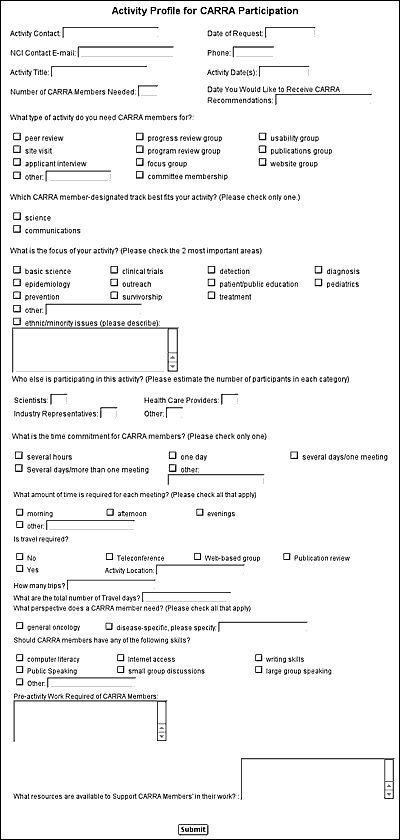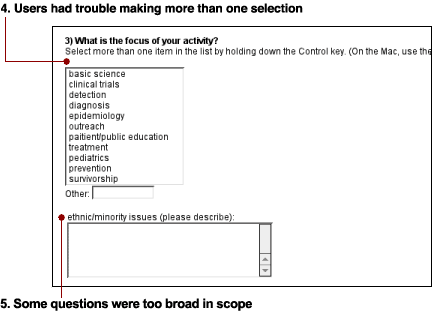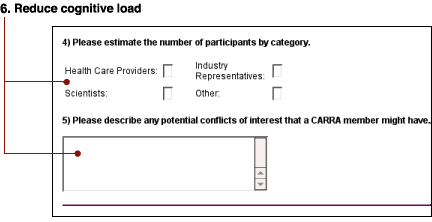 |
 |
|
|
Developing an Online Form
Creating an online form can present developers with many challenges. This case study reviews how a paper-based form was taken through the usability engineering process to develop a functional online version. We discuss the steps in planning and research, prototype development, test design, and the usability test results. CARRA - Consumer Advocates in Research and Related Activities The National Cancer Institute (NCI) developed the Consumer Advocates in Research and Related Activities (CARRA) program to increase the involvement of people affected by cancer in NCI activities. A Web site was built to educate CARRA members about their roles and responsibilities. One of the features of the site was to provide a method for NCI staff members to request consumer advocates for participation in their research activities. An online form was developed for this purpose. Lessons Learned 1. A form that works on paper may not necessarily work online. Determine the goal(s) of the form and what information needs to be collected up front before the form is designed. We were given an
existing paper-based form that was designed to serve as a direct interface
to an internal database. The fields on the paper form were matched to
the fields in the database. The goal was to automate the CARRA member
selection process, by putting the paper form on the Web and linking
it to the database.
This is consistent with one of our guidelines: Set and State Goals. Paper Prototype
Original HTML mock-up
2. Don't ask for the same information more than once; collect only information that you are going to use. The original paper-based form had a number of questions that were duplicative. We eliminated the ones that were unnecessary to avoid having users re-enter the same information in different ways. Original Questions 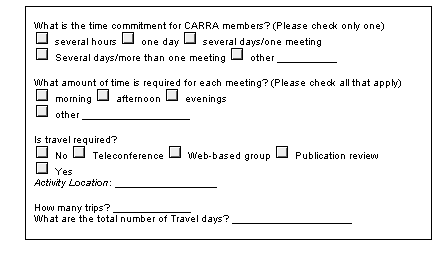 Revised Questions 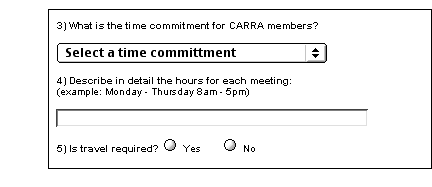 3. Provide a logical structure. We then decided
to review current research on effective form design, as well as look
at other forms on the Web to determine how they were being used to collect
information, and what aspects of existing forms online would fit our
needs. We paid close attention to the style, organization, layout, field
labels, use of widgets, and other elements integral to form design.
4. Use appropriate form elements (widgets) for the type of question you're asking. We went through each question and field on the form to determine the most appropriate widget to use. The goal was to minimize user workload by maintaining consistency among widget types. Our design decisions were based on the following guidelines:
First iteration after usability engineering
Lessons Learned 1. Identify problem
areas on the form and anticipate usability issues to test. 2. Determine the characteristics of your users and develop user profiles. We determined that there would be two different types of users; those who have a science background, and those who work in health communications. We began writing scenarios for each of the user profiles by looking at the questions on the form, and trying to determine, field by field, what was essential information that needed to be provided in the scenario, and what can be inferred by the user within the context of the scenario.
Ultimately, we interviewed one participant of each of the user types and developed scenarios that reflected the way they approached an activity, which was quite different than the linear approach we were going to take.
During testing, participants were asked if they had ever requested a CARRA member for one of their research activities. If they had, users were then instructed to fill out the form as if they were requesting one for that activity and told to make up any information if they forgot certain details related to it. A "science" or a "communications" activity scenario was provided if users had never requested a CARRA member (to match the user profiles). All participants had used CARRA in the past and filled out the form without the use of the scenarios. This reflected more of a "real-world" situation for users. 3. The testing protocol for an online form differs from traditional scenario-based tasks. A performance-based usability test was employed using a think aloud protocol. Several techniques were used to solicit participant feedback during this test. Participants were asked to fill out the prototype of the form online. They were asked to describe out loud how they were attempting to complete each field as they worked on them. After they completed filling out the form, the test facilitator performed a critical-incident analysis by following up on the participants' actions/comments and asking questions to clarify comments made or to encourage the participant to continue describing his/her actions. Observers took notes of user comments and actions during test performance. All tests were video recorded. Finally, participants answered seven general questions about their overall impressions of the form. Each test was approximately 1 hour. Lessons Learned 1. Avoid using
jargon; use clear, simple language for all field labels and questions. 2. Provide a context for filling out the form. Users wanted a context as to why they were filling out the form and when they would receive a response. They also wanted to be able to contact CARRA if they needed to follow up on their request. This information was added at the top of the form. This is consistent with one of our guidelines: Provide Feedback to Users. See image below. 3. Include field formatting instructions, if necessary. Users weren't sure
if they should put their internal office phone extensions, or full phone
number. See image below.
4. Ensure form elements (widgets) can actually be used. Users had difficulty selecting more than one option in the open-list boxes; some text boxes didn't have enough space for users to enter the information they wanted to. See image below. 5. Ensure all questions are worded clearly. Questions that are
vague or not written clearly will cause confusion and users won't know
how to answer them. One field, "ethnic/minority issues (please
describe)" was for users to indicate if they wanted CARRA members
of a certain race or ethnicity. 6. Reduce cognitive
load in a form; don't make users think (humans don't think like a database).
Overall, users experienced general frustration while filling out the Activity Profile form. It did not meet their expectations. This form was initially
designed for multiple purposes and audiences: This test demonstrated many of the problems associated with taking a tracking form that is defined by an internal database, and using it to serve a purpose for which it was not originally intended. By conducting this usability test, we discovered that the form did not meet users' expectations. The form was modified by providing text boxes where users could enter an open-ended, narrative text description of their activity and the characteristics they are looking for in a CARRA member. Further testing on the redesigned form should be conducted to reevaluate these changes. View a sample of the final form. (this link opens a new window) For More Information Information about
the CARRA program: http://la.cancer.gov/carra. |
|
|||||||||||||||

